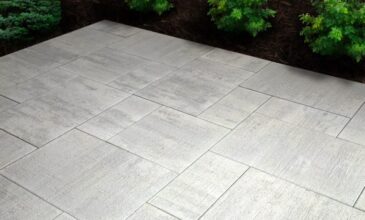Studies show repurposed coffee grounds can benefit turfgrass, landscapes
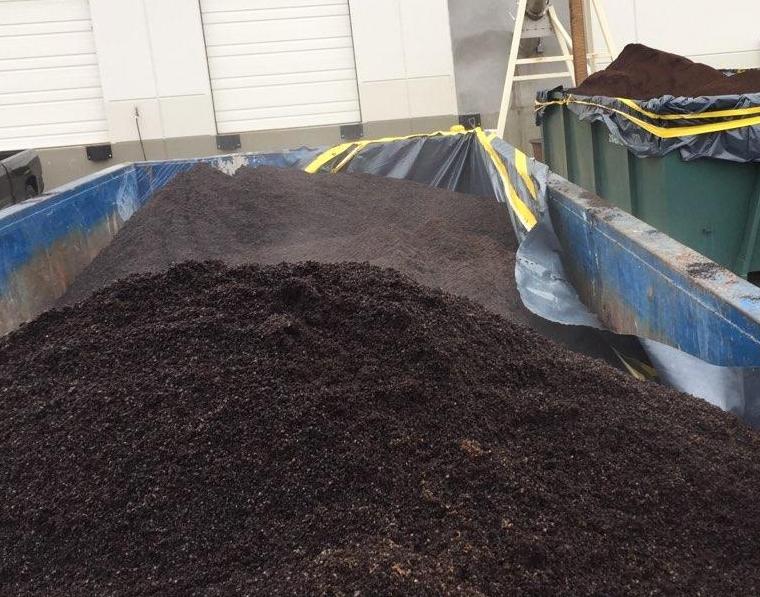
By Kay Ledbetter
Remember when grandma dumped her coffee grounds on the flowerbed and garden? Well, she was on to something.
Ben Wherley, Ph.D., Texas A&M AgriLife Research turfgrass ecologist in the Texas A&M Department of Soil and Crop Sciences, College Station, has taken advantage of the growing popularity in cold-brewed coffee and the truckloads of spent coffee grounds not previously available.
He and master’s student Garrett Flores recently concluded two studies to determine how much value these cast-off coffee grounds might have.
Their study attracted the attention and a seed grant from the U.S. Golf Association Green Section as well as GeoJava, a company started by Chad McNair, CEO of Aspen Beverage Group in San Antonio.
Grounds for more than just coffee
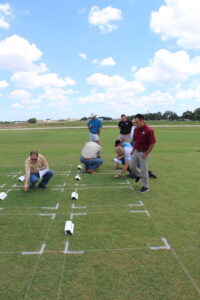
“Initially I thought it was kind of cute and quaint that someone would be looking at coffee grounds picked up from Starbucks or the local convenience store to try to build a product around,” said David Mayer, owner of Mayer Materials, Fort Worth, Texas. “We have been using coffee chaff from the two largest coffee roasting companies up here for years as a key component in our compost products, but never had the volume to justify looking at it as a standalone product line.”
After visiting with Wherley’s team, Mayer said they quickly realized that spent coffee grounds may have potential not only to improve existing fertilizer performance but also to potentially rival peat moss – a non-renewable resource – as a viable organic matter component in U.S. Golf Association, (USGA) rootzone mixes.
The USGA has specific guidelines for rootzone mixes, which must include organic matter to improve the water holding capacity of the soil. Peat moss is the most commonly used organic matter at this time.
Gaining momentum in industry
“We were most excited about this part of the research, for it could have an enormous impact in the golf course and sports field construction industry,” said Mayer.
A partnership with McNair and his team was created, Texas Java Partners LLC, that researches, develops and produces coffee-based fertilizers, composts and organic matter root-zone amendment products.
Wherley said Aspen Beverage Group supplied much of the spent coffee grounds for his team’s research projects, which looked at the cast-off products as a surface application, perhaps as a fertilizer or compost, and as a soil rootzone amendment in sand-based systems.
Spent coffee grounds have about a 2.5 to 3 percent nitrogen content, and a carbon-to-nitrogen ratio of about 20 to 1, which seemingly could make them desirable for fertilizer application, said Wherley.
Wherley and Flores compared fresh and composted grounds to other organic and synthetic fertilizers and sphagnum peat moss, which is commonly used as a soil amendment in sand-based sports fields and golf course putting greens.
Studying fertilizer benefits of coffee grounds
The two-year topdressing fertilizer study tested seven different organic and synthetic fertilizers against coffee grounds – fresh and composted – as well as a control. The study also tested two application rates for each treatment.
“Our observation from this study determined that direct application of spent coffee grounds by themselves provided minimal benefit,” said Flores. “However, when the spent coffee grounds were added with another source of fertility, the nutrients appear to be retained over an extended period compared to organic and especially synthetic fertilizers.”
An alternative to peat moss?
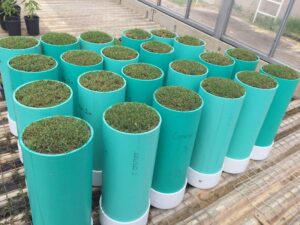
In the soil amendment research, Flores said the focus was to determine if spent coffee grounds could serve as an alternative rootzone amendment to sphagnum peat moss.
The treatments studies included coarse spent coffee grounds, fine spent coffee grounds and peat moss – all added at 10 percent and 20 percent by volume – and straight sand as a control. Coarse and fine spent coffee grounds were compared primarily to understand the differences in nutrient and water retention and resulting benefits on turf growth.
Flores said their observations from two separate greenhouse studies using Tifway bermudagrass showed a temporary period of mild chlorosis during the initial four to six weeks of establishment. However, growth, color, density and nutrient retention over the subsequent three months following an initial application of nitrogen fertilizer were as good or better in the columns amended with spent coffee grounds than those amended with peat moss or the sand-alone control treatments.
Treatments were also subjected to a six-week dry-down period at the conclusion of each study to determine how many days treatments could go before wilt was observed.
Coffee-ground-amended rootzones did not show wilt until later in the dry-down period compared to other treatments, and they also showed much stronger recovery and vigor after re-wetting, said Flores.
“While additional testing is still needed, the results suggest spent coffee grounds may offer good potential for use as a sand rootzone amendment in turf and landscape situations,” said Wherley. “Also, while showing little benefit when topically applied alone, when combined with another nutrient source they show good promise, which suggests they may work well as an ingredient in organic fertilizer production.”
In the field
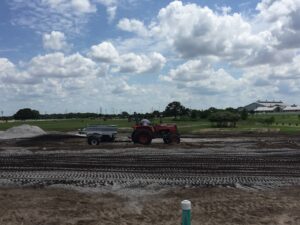
In a larger demonstration test, Wherley’s group used spent coffee grounds as a sand rootzone amendment in a 13,000-square-foot natural grass putting course they recently constructed at their research field laboratory in College Station.
“After just under a year, the grass appears to be doing very well,” said Wherley.
Mayer said they are thrilled with the results of the research and were able to use it in the production of several new products for the market this spring.
“Dr. Wherley and his team noted that coffee had this remarkable ability, and our partners at Sigma Agri-Science and American Plant Food identified a way to harness this potential to produce a hybrid lawn and turfgrass fertilizer product,” said Mayer. “We have already moved lots of this product into the landscape market and retail garden centers for spring applications this year.”
Kay Ledbetter is Texas A&M AgriLife communications specialist. For more information, contact Ledbetter at skledbetter@ag.tamu.edu or Ben Wherley, Ph.D., at b-wherley@tamu.edu.
Editor’s Note: This article originally appeared in the June issue of SportsField Management, sister publication to Landscape Business.
Top photo: Used coffee grounds being generated from Aspen Beverage, San Antonio. Photo by Chad McNair.


